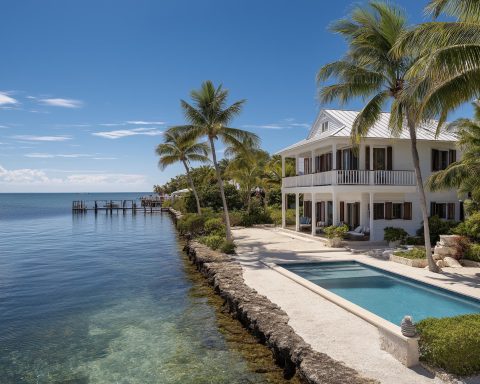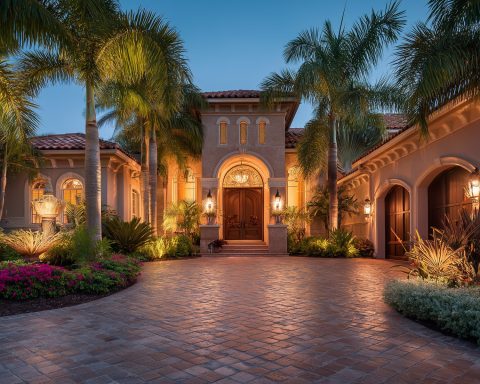Key Facts
- Mortgage Relief in North America: U.S. mortgage rates fell to a three-year low (~6.13% for 30-year fixed) amid expectations of a Federal Reserve rate cut whitehouse.gov. Canadian home sales ticked up in August as interest rate cuts began to rekindle buyer confidence rbc.com rbc.com.
- Europe’s “Zombieland” Slump: European commercial real estate remains stagnant, with sales near decade lows. An industry executive warned of “no recovery, stranded assets, no liquidity” in what he dubbed a market “zombieland” reuters.com. Despite this gloom, housing markets in many European countries are expected to bottom out and turn upward in 2025 as borrowing costs gradually ease fitchratings.com.
- Asia-Pacific Divergence: China’s property downturn deepened – new home prices fell ~0.3% in August (–2.5% year-on-year) reuters.com reuters.com, prompting officials to consider looser credit, easing buyer curbs and possible rate cuts around Sept. 20 reuters.com. In contrast, other Asia-Pacific markets like India and Japan stay resilient, with India’s developers seeing strong demand for warehousing and Japan enjoying inflows from yield-seeking investors (helped by ultra-low rates).
- Middle East Real Estate Boom: Gulf markets surged on robust demand and investor confidence. Dubai’s property sales hit AED 326.6 billion in H1 2025 – a 40% jump year-on-year masidproperties.com – amid soaring prices (Dubai home values are ~70% higher than 2019 levels) and record transaction volumes. Major deals also underscored global interest, such as Blackstone’s $525 million stake in a Dubai real estate portal masidproperties.com.
- African Growth Amid Challenges: African real estate is expanding (~5–8% growth forecast in 2025 for key markets businessday.ng) driven by urbanization and demand for affordable housing. Experts urge policy reforms and foreign investment to unlock its potential. “Africa’s real estate market is dynamic and can turn the economy’s fortunes if well harnessed,” said Professor Timothy Nubi of University of Lagos businessday.ng. Key cities like Nairobi, Lagos and Accra are emerging as investment hubs, though developers face hurdles from financing gaps to infrastructure needs.
- Latin America on Recovery Path: Latin American markets showed signs of recovery as interest rates began to come down from historic highs. In Chile, after a 13% home sales drop in 2024, a 5–10% rebound is expected in 2025 thanks to improved mortgage access and falling rates adventuresincre.com. Brazil’s central bank, still battling ~15% rates, signaled plans to boost real estate credit availability as savings-funded lending wanes reuters.com reuters.com. Mexico’s industrial property sector boomed on nearshoring demand, with companies rushing to build factories and warehouses closer to the U.S. vallartadaily.com.
- Tech & Innovation: PropTech investment and innovation are accelerating worldwide. From AI-driven property management to VR home tours, digital tools are now integral to real estate operations technews180.com. Notably, the UAE’s RAK Properties began accepting cryptocurrency for home sales in a pilot project masidproperties.com, and industry giants like Zillow and Redfin continue to expand online platforms. A National Association of Realtors survey highlighted that agents increasingly rely on AI, CRMs, and automation to stay competitive nar.realtor nar.realtor.
North America
Residential Market: North America’s housing sector showed mixed signals but with growing optimism. In the United States, mortgage rates declined for a third straight week, hitting ~6.1% – the lowest since late 2022 whitehouse.gov. This rate relief, combined with moderating inflation, improved affordability for buyers. Home inventory has climbed – active listings in the U.S. were up 26% year-on-year in July, the 7th consecutive month of growth churchillmortgage.com. Sellers have slowly started to capitulate on pricing, leading to a modest cooling of home prices in some overheated markets. “We’re finally seeing buyers catch a break in pricey metros,” Redfin noted, as rising inventory and slight price declines eased income requirements for homeownership churchillmortgage.com. In Canada, the story is one of cautious rebound. Early reports from local real estate boards showed home sales picking up from mid-year lows in cities like Vancouver and Montreal rbc.com. “These developments are in line with our view that rebuilding market confidence will support a slow recovery in the second half of 2025,” observed RBC Economics rbc.com. With the Bank of Canada cutting its policy rate to 2.5% by mid-September mlacanada.com, Canadians saw slight relief in mortgage costs, aiding first-time buyers. However, high household debt and still-elevated home prices in Toronto and Vancouver kept the recovery “bumpy” and regionally uneven, as RBC noted—markets with abundant inventory (e.g. parts of Ontario and Alberta) continued to see prices soften rbc.com.
Commercial & Industrial: The U.S. commercial real estate sector is navigating a turning point. Transaction volumes ticked up 3.8% year-on-year in Q2 2025 (to $115 billion) altusgroup.com, suggesting investors are tiptoeing back after a prolonged slowdown. Notably, multifamily deals surged by nearly 40% (to $34 billion in Q2) as investors bet on strong rental demand altusgroup.com. Even the hard-hit office sector saw an 11.8% uptick in deals by dollar volume altusgroup.com, though this was driven by a few high-quality assets trading at discounted prices. Despite improving sales, valuations remained under pressure – property price indices are still below their 2022 peaks, and transaction counts are down, indicating many sellers and buyers remain apart on pricing altusgroup.com. “Operational resilience is now the key driver of performance, more than financial engineering,” one mid-year report noted, as investors focus on properties with solid income in a higher-rate environment altusgroup.com altusgroup.com. Industrial real estate continues to shine as a relative bright spot: demand for logistics facilities and warehouses stays robust thanks to e-commerce and, in Mexico, the nearshoring boom. In Mexico, manufacturing relocations have spurred a “surging” industrial property sector vallartadaily.com, especially in northern hubs like Monterrey and Chihuahua. However, in the U.S. and Canada, industrial deal volume cooled slightly in early Q3 (U.S. industrial transactions –6.3% year-on-year in Q2) altusgroup.com as some big-box developers paused new projects amid economic uncertainty.
Policy & Commentary: Macroeconomic shifts heavily influenced North American real estate. The Federal Reserve held its benchmark rate steady in September, but expectations of an imminent pivot to rate cuts have grown, helping fuel the mortgage rate declines whitehouse.gov. The White House even touted the mortgage drop as evidence that “President Donald J. Trump [is] making good on his promise to lower costs” for homebuyers whitehouse.gov whitehouse.gov. In Canada, policymakers similarly indicated that inflation was coming under control, allowing easing of monetary policy. Industry leaders are urging structural measures alongside monetary easing: in Washington, a national housing emergency declaration is under consideration to tackle affordability via lower closing costs and streamlined zoning churchillmortgage.com. And in Canada, analysts predict government programs in 2026 may expand support for first-time buyers and purpose-built rentals to address supply shortages. The consensus among North American real estate experts is cautious optimism – lower interest rates and strong job markets could “soft-land” the housing correction, but affordability remains a core concern as price-to-income ratios are still stretched in many cities.
Europe
Market Activity: Europe’s real estate markets are struggling to shake off a pandemic-era malaise. Commercial property investment is at rock-bottom levels, with year-to-date sales volume in early Q3 2025 roughly half the level of three years ago reuters.com. “We have ‘zombieland’… no recovery, stranded assets, no liquidity coming back,” said Sebastiano Ferrante, PGIM’s head of European real estate, bluntly summing up the mood reuters.com. Would-be sellers of offices and retail centers are often unwilling to accept lower prices, leading to a stalemate in deal-making. Preliminary data for Q2 showed cross-border property investment in Europe, the Middle East and Africa down ~20% year-on-year – the worst Q2 in a decade according to Knight Frank reuters.com. Particularly hard hit is the office sector in secondary locations: older offices and fringe-area shopping malls are “struggling to find buyers,” Ferrante noted, even as select segments like logistics and hotels still see opportunistic interest reuters.com.
Residential & Prices: The European housing market presents a mixed picture. After falling in 2023–24, home prices in many countries are now approaching a floor. A Fitch Ratings outlook suggests most European housing markets will see price rises in 2025, albeit modest ones, as mortgage rates gradually come down and household incomes grow fitchratings.com. Already, French and Spanish home prices are showing signs of stabilizing after slight dips, and Germany’s steep decline (exacerbated by a building slowdown and economic recession) is expected to bottom out by late 2025. Mortgage costs remain high historically, but off their peaks – for example, the average new mortgage rate in the UK is now around 5%, down from 6%+ earlier in the year as the Bank of England’s hiking cycle ended. Indeed, central banks in Europe are pivoting: the BoE is forecast to cut rates three times by year-end 2025 (to ~3.5%) as inflation retreats towards target mediaassets.cbre.com. Similarly, the European Central Bank signaled that the July rate hike was likely its last, with potential rate relief in 2026. Lower financing costs should gradually improve buyer demand. However, any recovery in housing is uneven – “In some parts of the market the recovery is well under way… [but] there are out-of-favor assets and sectors where there is almost no liquidity and more pain to come,” observed Cecile Retaureau of Phoenix Group’s investment arm reuters.com, referring to the divergence between resilient segments (like undersupplied rental housing) and those still in slump (e.g. offices). Notably, Europe’s rental markets remain robust: chronic undersupply of rental housing in major cities has kept rents rising and attracted investor interest even as property values fell reuters.com.
Notable Developments & Policy: A few high-profile situations illustrate Europe’s challenges. In Germany, a prominent Frankfurt skyscraper (the Trianon Tower) entered insolvency and was put up for a distressed sale – a test of the fragile German market’s pricing reuters.com. In London, Brookfield shelved the sale of its CityPoint office tower after bids came in far below expectations, instead asking bondholders to approve a debt restructuring reuters.com. These episodes underscore the valuation gap facing landlords. Governments are responding with some supportive measures: France and Spain extended certain buyer incentive programs and loosened lending caps to prop up home purchases, while Germany is mulling tax breaks to spur renovations and energy-efficient upgrades (doubling as economic stimulus). Meanwhile, the sustainability push continues – EU regulations on building energy performance are pressuring owners of older, inefficient buildings to retrofit or sell, which in time could create both challenges and new investment opportunities. On the monetary side, Europe’s improving inflation outlook is a silver lining. “The prospect of international cash shifting to Europe from the volatile U.S. market could help,” noted Konstantin Kortmann, JLL’s Germany CEO, who expects a slow gradual recovery once interest rates ease and global investors regain risk appetite reuters.com. For now, Europe’s real estate remains in a holding pattern, awaiting that inflection point.
Asia-Pacific
China’s Property Woes: The spotlight in Asia-Pacific remains on China’s real estate turmoil, which continues to reverberate through the region. The country’s once-mighty property sector – accounting for about a quarter of China’s economy – is mired in a protracted downturn. New home prices fell 0.3% in August (month-on-month), marking the fourth straight month of decline reuters.com. Prices are down 2.5% from a year earlier, and even steeper drops persist in the resale market (resale home prices in major cities are off 3–6% year-on-year depending on city tier) reuters.com. “Based on current data and market trends, the real estate market is likely to face significant adjustment pressure in the near term,” warned Zhang Dawei, a chief analyst at Centaline Property, adding that the market is anticipating stronger government measures to stabilize housing demand reuters.com. Indeed, Chinese authorities have rolled out a flurry of support policies in recent weeks: major cities like Shanghai and Shenzhen eased home-purchase restrictions (lifting some limits on second-home purchases) reuters.com; banks cut mortgage rates for existing borrowers; and the central government urged local governments to speed up shantytown redevelopment and other demand-driving programs reuters.com reuters.com. The People’s Bank of China signaled possible cuts to benchmark lending rates (Loan Prime Rate) around late September, though as of Sept 21 the 1-year LPR remained unchanged at 3.45% and the 5-year at 4.20%, as policymakers balance stimulus with concern over capital outflows investing.com tradingeconomics.com. The continued troubles of major developers (Evergrande’s restructuring setbacks, Country Garden’s liquidity crisis, etc.) and weak buyer sentiment – hurt by high unsold inventory and economic uncertainty – suggest that China’s property slump will not see a quick turnaround. Analysts now expect home prices to stabilise only by 2026 or 2027, about half a year later than previously hoped reuters.com.
Broader Asia-Pacific Trends: Outside China, real estate trends are more upbeat. India’s property market is buoyant, underpinned by rapid economic growth (~6% GDP growth) and urbanization. Major Indian cities have robust housing demand; developers are reporting strong pre-sales in new projects, although higher interest rates (the Reserve Bank of India held rates at 6.5% through Q3) have slightly tempered the pace. Industrial and logistics real estate is thriving in India and Southeast Asia as global manufacturers diversify supply chains away from China. For instance, Vietnam and India have both seen double-digit growth in warehouse leases in 2025, catering to electronics and textile sectors. Japan’s real estate remains attractive to international investors – Tokyo office towers and apartments are drawing interest as the Bank of Japan maintains ultra-low rates, keeping borrowing costs near zero. While the BoJ has begun tweaking its yield-curve control (allowing 10-year government yields up to 1%), the overall monetary stance is accommodative, and Japan’s property yields (often 3–4%) look appealing compared to near-zero bond yields consultancy-me.com. However, Japan faces its own challenges: vacancy in older offices has inched up (Tokyo’s Grade B office vacancy hit ~6%), and the population is aging/shrinking, which over the long term softens housing demand. Australia and New Zealand saw housing prices begin to rise again in 2025 after sharp corrections in 2022–23. In Sydney and Melbourne, low inventory and persistent population growth (including rebounding immigration) have led to bidding wars resuming for quality homes, even as the Reserve Bank of Australia keeps rates at post-pandemic highs (~4.1%). By contrast, South Korea and Hong Kong are still in cooling mode – Seoul’s apartment prices remain about 20% below their 2021 peak, and Hong Kong’s market is subdued by rising borrowing costs and emigration.
Tech Innovations & Regional Notes: Across Asia-Pacific, the intersection of technology and real estate is a growing theme. PropTech adoption is accelerating in the region – for example, Japan and Singapore are investing in digital twin technology to manage buildings, and India’s startup scene has produced unicorns offering AI-driven property brokerage and mortgage platforms. This was evident at PropTech Connect 2025 in London (attended by many Asia-Pac firms), where global real estate professionals noted that “AI has become our colleague” in tasks like valuation and property management, even if the initial hype has leveled off buildext.com buildext.com. Another trend is sustainability: green building standards and retrofitting are front-of-mind, especially in markets like Australia where investors now favor properties with strong ESG credentials. Quotes and commentary reflect a cautious optimism in the region. “The market is slowly transforming… data-based decision-making [with AI] will replace trust-based decisions once reliability is proven,” one PropTech leader observed, predicting better long-term outcomes buildext.com buildext.com. Meanwhile, regional economists note that if the U.S. and Europe begin easing monetary policy as expected, it will relieve pressure on Asian central banks, potentially boosting real estate by late 2025. In sum, Asia-Pacific’s real estate landscape is a study in contrasts: China’s slump is a drag, but elsewhere a combination of tech innovation, demographic demand, and (in time) lower interest rates points to resilience and growth.
Middle East
Booming Gulf Markets: Real estate in the Middle East – especially the Gulf Cooperation Council (GCC) countries – is in the midst of a remarkable upswing. The UAE, Saudi Arabia, Qatar, and their neighbors are enjoying strong property market growth fueled by economic diversification plans, population inflows, and ample liquidity. Dubai continues to dominate headlines: the emirate is now ranked among the world’s top 3 prime residential markets for price growth, with prime home values up over 5% in H1 2025 consultancy-me.com. Overall Dubai housing prices have surged about 70% since 2019, and 2025 sales volumes are shattering records. In fact, Dubai recorded 51,000 home sales in Q2 2025, the highest quarterly number ever, as local and foreign buyers poured in (some drawn by Golden Visas and tax-free investment perks). Transaction value in Dubai hit AED 326.6 billion in the first half of 2025, up 40% year-on-year masidproperties.com. High-demand areas – Downtown Dubai, Dubai Marina, Business Bay – led the charge in sales masidproperties.com. Developers are responding with a pipeline of new projects, though supply still lags demand in the luxury segment. Neighboring Abu Dhabi also saw a strong surge: Q1 2025 real estate transactions totaled ~AED 25.3 billion, a 34.5% jump from the prior year gulfnews.com, thanks to new master-planned communities and foreign investment (boosted by the Emirate’s growth initiatives and upcoming global events).
Investment & Innovation: A notable trend is international investment and tech innovation in Middle Eastern real estate. Global investors are actively participating in the boom. For example, Permira and Blackstone’s $525 million investment for a minority stake in Dubai’s Property Finder (a major property portal) valued the platform at $2 billion masidproperties.com – a vote of confidence in the region’s PropTech and an acknowledgement of the growing role of digital platforms in the property market. Middle Eastern developers and agencies are also embracing financial innovation: RAK Properties (UAE) announced it will accept cryptocurrency payments (via a partnership with fintech Hubpay) for real estate purchases, starting with a luxury project in Ras Al Khaimah masidproperties.com. This groundbreaking move caters to global crypto-wealthy investors and underscores the tech-friendly approach Gulf markets are adopting. Additionally, the UAE continues to refine regulations to increase transparency: Dubai’s regulators introduced stricter rules on property listings and escrow accounts to curb speculation and protect buyers masidproperties.com. Brokers must now verify and register all listings on official databases, which is expected to boost trust and weed out dubious ads masidproperties.com.
Saudi Arabia & GCC Outlook: Beyond the UAE, Saudi Arabia’s real estate sector is accelerating as the Kingdom’s Vision 2030 initiatives drive construction and investment. A report by Kuwait Financial Centre “Markaz” highlighted strong activity in Saudi, UAE, and Kuwait in H1 2025, with rising property values and sales across residential, commercial, and hospitality segments arabnews.com arabnews.com. The momentum is expected to continue through H2 2025, “supported by lower interest rates, government investment, and resilient investor demand,” according to Markaz arabnews.com. Saudi Arabia in particular is seeing a construction boom: mega-projects like NEOM and the Red Sea tourism developments are underway, and Riyadh’s office market is tightening (prime office rents jumped 23% year-on-year as of Q1 2025 amid a shortage of Grade A space arabnews.com). The Saudi Real Estate Authority projects the Kingdom’s property market will reach $101 billion by 2029, growing ~8% annually arabnews.com. Qatar and Oman are also active – Qatar’s weekly real estate trading bulletins showed a surge in September deals (e.g. QR 394 million worth of property sales in the first week of Sept, +18.5% from the prior week) arabnews.com arabnews.com, indicating post-World Cup momentum in its market. Meanwhile, Middle Eastern investors are increasingly influential abroad: GCC sovereign wealth funds and developers have been on a global buying spree, snapping up trophy assets from London to Singapore, thanks to windfall oil revenues from recent years.
Macro and Risks: The macroeconomic backdrop in the Middle East remains favorable. Most GCC countries have pegged currencies (e.g. UAE dirham, Saudi riyal), meaning U.S. Fed rate moves transmit directly – the recent hints of Fed easing in 2025 bode well for slightly lower borrowing costs in the Gulf. So far, interest rates in the GCC have been high (UAE mortgage rates ~5–6%), but robust demand meant it hardly slowed the market. If global rates indeed fall, it could further boost Middle Eastern real estate by reducing financing costs for developers and consumers. Inflation in the GCC is relatively tame and oil prices, while volatile, are providing governments with the fiscal space to continue expansive projects. The main risks on the horizon include potential overheating – for instance, Dubai’s spectacular boom has some analysts cautioning about a possible bubble forming bloomberg.com. Memories of the 2009 Dubai property crash linger, prompting authorities to vigilantly employ macroprudential tools (like caps on speculative off-plan flipping and stricter lending limits) to prevent runaway speculation. Nonetheless, the current rally has been driven more by fundamentals (population and wealth growth, and limited new supply in key segments) than the leverage-fueled frenzy of the past. As one expert commented: “Global confidence [in the Gulf] is high – billion-dollar tech investments, an influx of foreign buyers, and regulatory tweaks show a maturing market” masidproperties.com. Barring external shocks, the Middle East’s real estate upswing looks set to continue into 2026, positioning the region as a standout performer on the global stage.
Africa
Growth and Demand: Across Africa, real estate markets are gradually gaining momentum in 2025. The continent’s property sector is expected to reach a total value of $17.6 trillion by 2025, with the residential segment dominating at ~$14.9 trillion businessamlive.com businessamlive.com. Several factors drive this growth: rapid urbanization, a rising middle class, and chronic housing undersupply in many cities. For example, Nigeria’s real estate sector is projected to grow between 6% and 8% in 2025, boosted by massive housing demand from its population of over 200 million businessday.ng businessday.ng. Likewise, Kenya’s property market in September 2025 “remains resilient and attractive, offering strong returns” in both residential and commercial segments serrarigroup.com. Infrastructure investments (new roads, rail, ports) and government housing initiatives are opening up previously inaccessible areas for development serrarigroup.com. Key urban centers such as Nairobi, Lagos, Cape Town, Johannesburg, Accra, and Cairo are often cited as property investment hotspots, where housing, office space, and retail demand is outpacing current supply rprealtyplus.com estateintel.com. Notably, housing shortages are acute – Nigeria has an estimated 28 million-unit housing backlog, Kenya about 2 million, and even South Africa (one of the continent’s more developed markets) faces a 2+ million unit deficit businessamlive.com. This underpins the long-term need for residential construction across the region.
Policy & Investment Climate: African real estate experts are calling for greater investment and policy alignment to unlock the sector’s full potential. At a recent conference in Lagos, Nigeria, stakeholders emphasized the need for government and private sector collaboration. “Africa’s real estate market is dynamic and has the potential to turn the fortunes of the economy if well harnessed,” said Professor Timothy Nubi, urging officials to implement supportive policies businessday.ng. In Nigeria, real estate currently contributes only ~5.5% of GDP (versus 18–20% in advanced economies) businessday.ng, highlighting room for growth. To bridge financing gaps, experts like Nubi advocate attracting foreign capital and establishing real estate investment trusts (REITs) and public-private partnerships. Some positive steps: Nigeria launched a land registration e-portal (e-GIS) in Lagos, digitizing land titles to increase transparency and reduce transaction delays businessamlive.com businessamlive.com. Rwanda rolled out an electronic land title system (“e-Title”) to cut red tape and fraud businessamlive.com. These innovations aim to improve the business climate and encourage investment. Additionally, Pan-African initiatives such as the African Development Bank’s housing fund and various diaspora investment programs are channeling new funding into property development. Meanwhile, investors from the Middle East and China are increasingly active in Africa – for instance, there’s growing Gulf investor interest in North African real estate, and Chinese firms continue to finance commercial projects (malls, industrial parks, etc.) in East and Southern Africa.
Sector Highlights: Within Africa, different real estate sectors show varied trends. Residential housing – especially affordable housing – is a top priority. Governments in Kenya, Ghana, and South Africa have schemes to incentivize affordable homebuilding (tax incentives, land grants, etc.), though results have been mixed. In Nigeria, private developers are teaming up with state authorities to launch mass housing schemes, yet high construction costs and infrastructure deficits pose challenges. Commercial real estate in major cities is recovering from the pandemic slump: office occupancy is rising again in cities like Nairobi and Lagos, partly due to tech and fintech companies expanding. Retail real estate is evolving too – modern shopping malls and mixed-use centers are opening in secondary cities, catering to a young consumer base. Industrial and logistics properties are in demand as e-commerce grows and as manufacturing looks to expand (for instance, Egypt and Ethiopia are building industrial zones to attract factories). A report from estateintel identified 5 African cities to watch for real estate investment in 2025 – Lagos, Nairobi, Accra, Kigali, and Cairo – all expected to benefit from a combination of economic growth and relative political stability rprealtyplus.com estateintel.com. Investors are particularly drawn to high-yield opportunities: yields on Grade A office or retail in Africa can be 8–10% or higher, reflecting both growth potential and perceived risk.
Risks and Outlook: Despite promising growth, Africa’s real estate market faces headwinds. Financing costs remain elevated – local mortgage rates often range from 15% to 25% (e.g., Nigeria’s central bank rate is in the mid-teens), which limits end-user buying power. Currency instability and inflation (in some countries) also pose risks to investors. Additionally, a lack of reliable market data in many African countries makes it hard for investors to assess risk; the African Real Estate Society recently warned that “inadequate data is stifling housing finance and investor confidence” in markets like Nigeria punchng.com punchng.com. Nonetheless, the outlook tilts positive. As one Nairobi-based investment group noted in a September update: “Kenya’s real estate sector [is] dynamic, resilient, and forward-looking… [delivering] above-average returns and attracting strong domestic and international interest” serrarigroup.com, even as developers navigate higher taxes and compliance hurdles. The same could be said for several African markets – the strong fundamental demand for property, combined with incremental improvements in governance and finance, is slowly but surely creating a more investable African real estate landscape. International conferences (like the AFRES summit in Lagos) and new platforms for investment (like pan-African REITs) in late 2025 are further evidence of growing interest. If governments can maintain stability and implement the right reforms, 2025–2026 may mark the beginning of a sustained uptrend for Africa’s real estate sector.
Latin America
Recovery Signs: In Latin America, real estate markets are cautiously edging toward recovery after a challenging period of high interest rates and economic slowdown. A standout trend is the shift in central bank policies: several Latin American central banks, having battled inflation with aggressive rate hikes in 2022–2023, began cutting rates in 2024–2025, which is now filtering through to property markets. For example, Brazil’s Selic rate, which stood at a 20-year high of 14.75% in early 2025 reuters.com, is expected to fall in coming months as inflation moderates. Lower rates should rejuvenate Brazil’s housing affordability – already, there’s talk of new programs to revive mortgage lending. Brazil’s central bank governor Gabriel Galipolo signaled an “imminent solution” to support real estate financing, given that high rates led to an outflow from savings (the traditional funding source for mortgages) reuters.com reuters.com. This “bridge” financing model, involving banks like Caixa, aims to ensure developers and homebuyers can access credit even as savings deposits shrink. Mexico is another closely watched market: its central bank has also started to ease policy slightly. Mexican housing demand has remained fairly robust, and the housing market is expected to maintain an upward trajectory into 2025, supported by structural demand, government subsidies for low-income buyers, and a young population globalpropertyguide.com.
Residential & Commercial Developments: Several countries are experiencing localized real estate booms. Colombia’s housing market is entering a recovery phase – building permits are up, and a renewed government subsidy program (“Mi Casa Ya”) is stimulating affordable housing construction bbvaresearch.com. Peru and Chile saw their housing markets bottom out in 2024; by mid-2025 sales volumes were creeping up again. In fact, in Chile, after a sharp 13% drop in home sales last year, experts forecast a 5–10% rebound in 2025, crediting improved mortgage availability and declining interest costs adventuresincre.com. Chile’s central bank has cut rates significantly (from 11.25% in 2023 to around 7.75% by Sept 2025), bolstering buyer sentiment. Additionally, demand for sustainable “green” housing is rising in Chile – 30% of new developments in Santiago now carry green building certifications, a 20% increase, reflecting buyer preferences for energy-efficient homes adventuresincre.com. In Argentina, an entirely different set of dynamics is at play: with inflation still extremely high, real estate operates on a cash-dollar basis. There has been a pickup in Argentine farmland and rural land sales as investors seek inflation hedges, but urban real estate remains in recession due to economic uncertainty. Commercial real estate in Latin America is mixed: office vacancy in big cities like São Paulo and Mexico City remains elevated post-pandemic (20%+ vacancy in São Paulo’s Grade A offices), yet the industrial real estate segment is booming across the region. The driver is nearshoring – as U.S. and global firms relocate supply chains closer, Mexico in particular has benefited. “Mexico’s industrial real estate sector is surging,” reports local media vallartadaily.com, with record-low vacancy in key logistics hubs (Monterrey, Tijuana, Ciudad Juárez all report <3% industrial vacancy). Developers are racing to add new industrial parks, though a Vallarta Daily report noted a slight early-2025 slowdown in deliveries due to permitting and labor bottlenecks vallartadaily.com vallartadaily.com. In Brazil, industrial and warehouse assets are also in demand, though investment was dampened by high interest costs earlier in the year.
Notable Transactions & Foreign Interest: Latin America has seen some major property transactions and investments around this period. In Mexico, international investors have partnered with local developers to fund industrial projects – for instance, funds from the U.S. and Asia are taking stakes in warehouse portfolios to capitalize on the nearshoring trend. Brazil recently witnessed one of its largest commercial property deals: a consortium led by global private equity acquired a portfolio of São Paulo office towers at a significant discount, betting on long-term recovery. Meanwhile, cross-border investment flows show Latin American investors themselves are active abroad: a Miami Realtors report highlighted that buyers from Latin America (Argentina, Colombia, Brazil, Mexico, etc.) accounted for 49% of new Miami-area condo purchases in an 18-month span miamirealtors.com, reflecting how wealthy Latin Americans often view U.S. real estate as a safe haven. Within the region, Panama and the Caribbean remain hotspots for second-home and expat property purchases, though these markets are smaller in scale.
Macro and Outlook: The macroeconomic environment in Latin America is improving relative to last year – inflation has eased in many countries, and currencies like the Brazilian real have stabilized or strengthened on the back of high interest rates (indeed, Brazil’s high rates made the real one of 2025’s better-performing currencies) en.clickpetroleoegas.com.br. With the U.S. Fed likely to cut rates in 2025, pressure will lessen on Latin America to keep rates high, giving further breathing room. One risk, however, is political uncertainty: elections and policy shifts (such as potential new taxes on property or rent control measures in some cities) could impact investor confidence. For now, the sentiment among regional real estate professionals is guarded optimism. “After a long winter, we’re finally seeing signs of spring in Latin housing markets,” said one analyst, pointing to the uptick in sales and construction in countries like Colombia and Chile. Additionally, as one report noted, “improved mortgage access and declining interest rates” are key to turning the tide adventuresincre.com – and those conditions are gradually falling into place. If the global economy avoids major shocks, Latin American real estate is poised for a slow but steady comeback through late 2025 and into 2026, led by the twin engines of lower interest rates and pent-up housing demand.
Sources: Global news and analysis from Reuters, Bloomberg, CNBC, RBC Economics, JLL, Knight Frank, National Association of Realtors, and regional publications whitehouse.gov reuters.com reuters.com masidproperties.com businessday.ng adventuresincre.com, among others.










